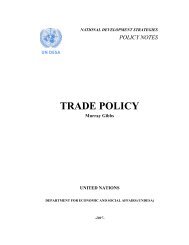16th Meeting of Senior Fellowships Officers of the ... - Development
16th Meeting of Senior Fellowships Officers of the ... - Development
16th Meeting of Senior Fellowships Officers of the ... - Development
You also want an ePaper? Increase the reach of your titles
YUMPU automatically turns print PDFs into web optimized ePapers that Google loves.
Administrative Issues 55<br />
external funding and had been funded by DCAAP earnings from training only. They<br />
included training management paradigms that deliberately integrated monitoring and<br />
evaluation as a component function. The functional steps <strong>of</strong> <strong>the</strong> paradigm were: training<br />
needs analysis, planning, staffing and organizing, directing and coordinating, conducting<br />
and implementing as well as monitoring and evaluating. That paradigm emphasized that<br />
training had been completed only when <strong>the</strong> evaluation report had been accepted by <strong>the</strong><br />
training manager. DCAAP emphasized monitoring and evaluation principles, methods,<br />
tools, formulae and processes as documented in its books. In particular, that included<br />
methods on how to ga<strong>the</strong>r monitoring and evaluation data, tools or tests for measuring<br />
participants gains in knowledge, attitude, skills and practice; formulae in computing <strong>the</strong><br />
level <strong>of</strong> knowledge, attitude, skill, and practice <strong>of</strong> participant gained from training as well<br />
as procedures in data organizing, processing and reporting<br />
180. DCAAP had started sharing those documented social technologies with its participants<br />
and o<strong>the</strong>r interested parties. Most <strong>of</strong> <strong>the</strong> information was presented in a booklet produced<br />
by DCAAP entitled “Measuring Training Effectiveness”. Mr. Mercado expressed<br />
his hope that UN could help DCAAP share <strong>the</strong> resource material in hard copy or online.<br />
181. Mr. Mercado addressed several problems that DCAAP continued to face in encouraging<br />
training institutions to establish training monitoring and evaluation mechanisms.<br />
Many organization managers, and even some training managers, still needed deeper<br />
understanding and appreciation <strong>of</strong> <strong>the</strong> value <strong>of</strong> monitoring and evaluation in improving<br />
training efficiency and cost-effectiveness. Many managers and staff still needed to<br />
be convinced that knowledge and attitude, <strong>the</strong> invisible fundamentals <strong>of</strong> heightened<br />
performance, could be developed through training and could be measured through<br />
systematic monitoring and evaluation. Many funding and implementing organizations<br />
showed interest in <strong>the</strong> results <strong>of</strong> monitoring and evaluation. Trained staff that could<br />
do systematic monitoring and evaluation <strong>of</strong> training programmes from planning to<br />
reporting was very limited. Dearth persisted <strong>of</strong> simplified guide resource materials that<br />
could be used by monitoring and evaluation staff in conducting simple but systematic<br />
monitoring and evaluation from planning to report writing. DCAAP had fur<strong>the</strong>r<br />
observed, and many <strong>of</strong> its participants had confirmed that observation, that most<br />
UN-assisted projects put much emphasis on <strong>the</strong> monitoring <strong>of</strong> inputs but not on <strong>the</strong><br />
monitoring <strong>of</strong> <strong>the</strong> corresponding outputs.<br />
182. To resolve those problems Mr. Mercado came up with six suggestions in his paper. A<br />
brief quality publication should be produced for organizations and project managers<br />
on <strong>the</strong> value <strong>of</strong> monitoring and evaluation in training showing its potential importance<br />
for improving <strong>the</strong> efficiency, quality, and cost-effectiveness <strong>of</strong> training programmes.<br />
Ano<strong>the</strong>r quality publication should be produced for managers and staff illustrating <strong>the</strong><br />
capacity <strong>of</strong> evaluation to measure systematically <strong>the</strong> effects <strong>of</strong> training on knowledge<br />
and attitude <strong>of</strong> training participants. The two suggested publications could also be<br />
combined into one advocacy material. Memoranda <strong>of</strong> Agreement between UN agen-

















